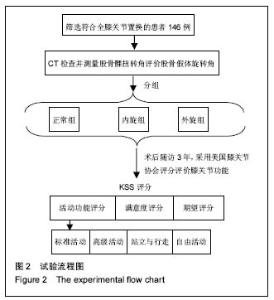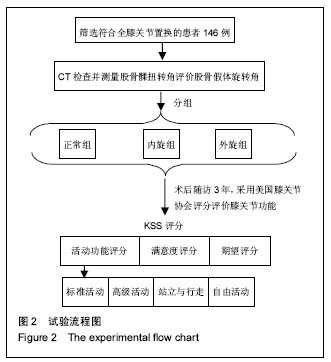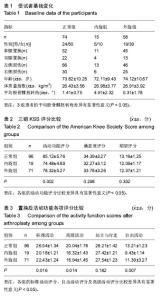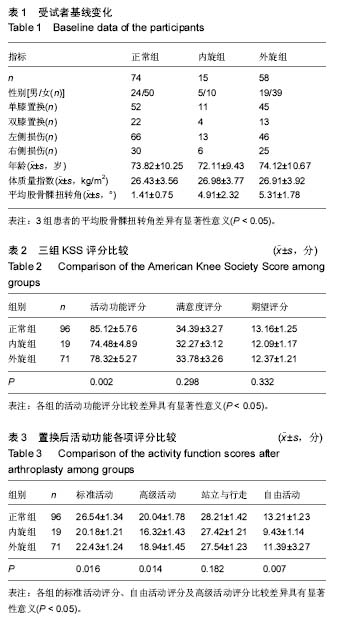| [1] 潘永谦,李健,张平,等.CT扫描在全膝关节置换中髌股关节轨迹不良股骨旋转力线的研究[J].中国矫形外科杂志,2014,22(20): 1895-1898.[2] Anneli H, Nina SK, Arja H, et al. Effect of total knee replacement surgery and postoperative 12 month home exercise program on gait parameters. Gait Posture. 2017. DOI: 10.1016/j.gaitpost.2017.01.004.[3] Ledin H, Good L, Aspenberg P. Denosumab reduces early migration in total knee replacement: a randomized controlled trial involving 50 patients. Acta Orthopaedica. 2017;88(3):1-4.[4] 肖瑜,张福江.全膝关节置换中胫骨假体旋转对线新技术[J].中国修复重建外科杂志,2008,22(1):26-28.[5] 黄媛霞,段永壮,王利民,等.人工全膝关节置换中髌股关节轨迹不良的处理策略及疗效[J].中国临床解剖学杂志,2017. DOI: 10.13418/j.issn.1001-165x.2017.02.021.[6] 朱永良,李煜明,颜超,等.外侧支持带松解对人工全膝关节置换置换后膝前痛的影响[J].中国修复重建外科杂志,2017.[7] 罗吉伟,余存泰.全膝关节置换的假体旋转力线不良与髌股关节并发症[J].南方医科大学学报,2006,26(2):217-219.[8] 姬林松,李彦林,黄赞,等.膝关节PS型固定与旋转平台假体对髌股关节应力的影响[J].实用医学杂志,2017. DOI: 10.3969/j.issn.1006-5725.2017.06.013[9] 王平,赵志江,付卫杰,等.人工全膝关节置换中股骨假体旋转的研究进展[J].中国修复重建外科杂志,2011,25(9):1140-1144.[10] 孙振辉,刘军,张宇,等.CT扫描确定全膝关节置换股骨假体旋转力线的研究[J].临床骨科杂志,2009,12(5):501-503.[11] 吴广鹏,徐耀增,朱永生,等.高屈曲旋转平台型假体全膝关节置换的近期随访:膝关节活动度及功能评价[J].中国组织工程研究, 2015,19(13):2011-2016.[12] Reddy KI, Johnston LR, Wang W, et al. Does the Oxford Knee Score complement, concur, or contradict the American Knee Society Score? J Arthroplasty. 2011;26(5):714-720.[13] 吕红芝,邢欣,秦士吉,等.2008年至2011年河北医科大学第三医院股骨髁上骨折置换后膝关节功能的相关因素调查与分析[J].中华创伤骨科杂志,2014,16(11):978-982.[14] 马军,牛东生,尚小可,等.全膝关节置换治疗严重膝外翻畸形的临床研究[J].中国矫形外科杂志,2011,19(11):897-899.[15] 王平,赵志江.人工全膝关节置换中股骨假体旋转的研究进展[J].中国修复重建外科杂志,2011,25(9):1140-1144.[16] 黄美贤,罗吉伟.三维螺旋CT重建股骨远端旋转力线的测量[J].中国临床解剖学杂志,2008,26(1):62-64.[17] 吴博,王岩,张国强,等.两种股骨截骨角度对膝关节置换术中股骨假体冠状位对线的影响[J].中国矫形外科杂志,2017. DOI: 10.3977/j.issn.1005-8478.2017.09.15.[18] 胡猛,李彦林,仝路,等.股骨远端旋转力线定位标志研究进展[J].中国修复重建外科杂志,2013,27(1):54-57.[19] 林源,曲铁兵,荀宝通,等.股骨远端旋转对线的初步研究[J].中华骨科杂志,2005,25(5):271-275.[20] Yoshino N, Takai S, Ohtsuki Y, et al. Computed tomography measurement of the surgical and clinical transepicondylar axis of the distal femur in osteoarthritic knees. J Arthroplasty. 2001;16(4):493-497.[21] Liau JJ, Cheng CK, Huang CH, et al. The effect of malalignment on stresses in polyethylene component of total knee prosthesis-a finite element analysis. Clin Biomech. 2002;17(2):140-146.[22] Ritter MA, Berend ME, Harty LD, et al. Predicting range of motion after revision total knee arthroplasty: clustering and log-linear regression analyses. J Arthroplasty. 2004;19(3): 338-343.[23] Boldt JG, Stiehl JB, Hodler J, et al. Femoral componentrotation and arthrofibrosis following mobilebearing total knee arthroplasty. Int Orthop. 2006;30(5):420-425.[24] Middleton FR, Palmer SH. How accurate is Whiteside's line as a reference axis in total knee arthroplasty. Knee. 2007; 14(3):204-207.[25] Kobayashi H, Aratake M, Akamatsu Y, et al. Reproducibility of condylar twist angle measurement using computed tomography and axial radiography of the distal femur. Orthop Traumatol Surg Res. 2014;100(8):885-890.[26] 姜侃,曲铁兵.人工膝关节置换中股骨远端旋转对线方法的研究与进展[J].中国矫形外科杂志,2013,21(21):2181-2183.[27] 严钰皓,唐蕾,彭笳宸.全膝关节置换中股骨旋转对线参照轴的研究进展[J].山东医药,2016,56(29):111-113.[28] 陈丹,周顺科,张亚林,等.探讨MDCT对股骨头旋转移位的分型诊断价值[J].临床放射学杂志,2015,34(3):423-426.[29] 秦晓平,杨柳,郭林,等.MRI辅助下膝关节骨关节炎伴内翻畸形患者股骨远端3种旋转轴线与外科经股骨上髁轴的准确性比较[J].第三军医大学学报,2015,37(9):930-933.[30] 陈识,关振鹏,张绍龙,等.股骨后髁角与股骨假体旋转对线在人工全膝关节置换中的应用[J].中华放射学杂志,2013,47(5): 470-471.[31] Epinette JA, Mertl P, Combourieu B, et al. Outcomes and prognostic factors in revision hip arthroplasty for severe intra-pelvic cup protrusion: 246 cases. Orthop Traumatol Surg Res. 2015;101(6 Suppl):S257-263.[32] Baier C, Fitz W, Craiovan B, et al. Improved kinematics of total knee replacement following partially navigated modified gap-balancing technique. Int Orthop. 2014;38(2):243-249. [33] Kitagawa A, Ishida K, Chin T, et al. Partial restoration of knee kinematics in severe valgus deformity using the medial-pivot total knee arthroplasty. Knee Surg Sports Traumatol Arthrosc. 2014;22(7):1599-1606. [34] Liu YL, Chen WC, Yeh WL, et al. Mimicking anatomical condylar configuration into knee prosthesis could improve knee kinematics after TKA-a computational simulation. Clin Biomech (Bristol, Avon). 2012;27(2):176-181.[35] Merican AM, Ghosh KM, Iranpour F, et al. The effect of femoral component rotation on the kinematics of the tibiofemoral and patellofemoral joints after total knee arthroplasty. Knee Surg Sports Traumatol Arthrosc. 2011; 19(9):1479-1487.[36] Heesterbeek PJ, Wymenga AB. Correction of axial and rotational alignment after medial and lateral releases during balanced gap TKA. A clinical study of 54 patients. Acta Orthop. 2010;81(3):347-353. [37] Catani F, Ensini A, Belvedere C, et al. In vivo kinematics and kinetics of a bi-cruciate substituting total knee arthroplasty: a combined fluoroscopic and gait analysis study. J Orthop Res. 2009;27(12):1569-1575. [38] Fantozzi S, Catani F, Ensini A, et al. Femoral rollback of cruciate-retaining and posterior-stabilized total knee replacements: in vivo fluoroscopic analysis during activities of daily living. J Orthop Res. 2006;24(12):2222-2229.[39] Zorman D, Etuin P, Jennart H, et al. Computer-assisted total knee arthroplasty: comparative results in a preliminary series of 72 cases. Acta Orthop Belg. 2005;71(6):696-702.[40] Lee GC, Cushner FD, Scuderi GR, et al. Optimizing patellofemoral tracking during total knee arthroplasty. J Knee Surg. 2004;17(3):144-150. |



